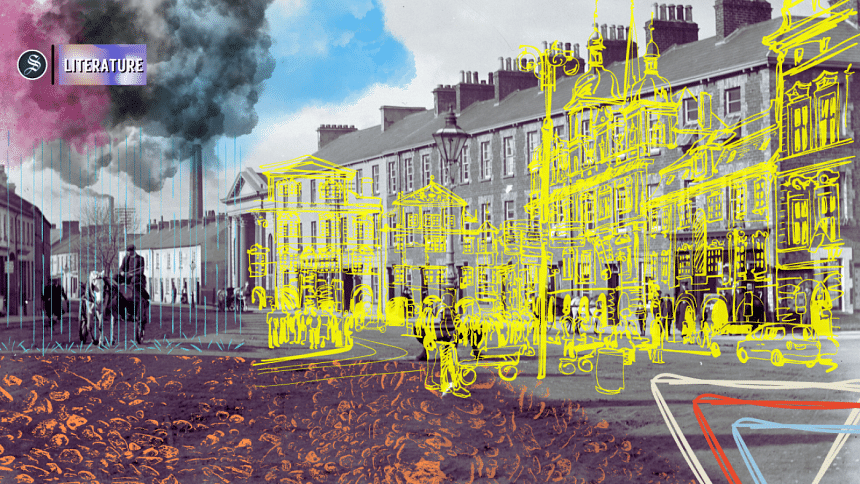James Joyce was never more profound than in 'Dubliners'

The geography of a city in all of its social, industrial, and personal complexity can perhaps never be fully outlined by words alone. A city is a being that sighs in sorrow and beams in happiness, yet stories can only take us so far to fully realise what lies behind these expressions. James Joyce, through practically every story he had to tell, sketched images of Dublin in the unending complexity hidden under layers of mundanity. To him, and to so many who went on to read Joyce, Ulysses (1920) was the magnum opus through which all of Dublin could—as he put it—be reconstructed were it to ever disappear from the face of the Earth.
But I don't fully agree here. Reading Ulysses today feels like an exercise done primarily to experience the way it is written than to experience the narrative itself. While it can be personal, Ulysses is also dense and overwhelming—too much to paint a coherent picture of a city; too opaque for it to feel like a space for humans to live in. The mundanity of living is very often muddled with monologues and streams of thought and consciousness, but the mundanity is what makes a city alive. It is what has made a city breathe like a living, breathing creature to me.
Dubliners (1914), a collection of 15 short stories, is a series of vignettes that serve this mundanity—but in doing so, it almost transcends it. Here, the everyday becomes almost hypnotic in its beauty, emotions are heightened to be all-consuming, and simple dinner banquets are grandiose celebrations of life and death in a city where too much seems to be happening all at once. Dublin, then a growing city faced with ever-growing economic disparity, has always been the subject of Joyce's works, but the progression presented here by starting the collection with stories of adolescence and then gradually building to stories of characters in their middle ages presents a picture of middle-class life in Dublin that feels almost complete.
The themes in the book are manifold. From "The Sisters", a story filled to the brim with characters limited in their capacity to express themselves—be it by age or the space they occupy—to "The Dead" and its almost boisterous celebration of the fleeting nature of life—the language of this book is nearly universal. The length of this book does not follow the same story, but make no mistake: the whole of this collection is one narrative, told through the eyes of many. A city is only made alive by the people who live in it, and it is only made to feel like its heart is beating when their lives, in all their imperfections, weave together like a delicate web.
Sorrow, love, and anguish cover the length and breadth of all the stories here, but to say that these quiet lives are all there is would be doing the book a disservice. Revolving around these emotions heightened by flowery, often lyrical, prose is a frequently unspoken, but very palpable, struggle with identity. Even from the very start with "The Sisters" featuring a child struggling to comprehend the world to "Araby" and its quiet descent from adolescent joy to bleak cynicism— there are hints of an internal battle to make sense of the world around you, and to have that give you a sense of belonging and identity. There is much to be said about every story featured here, but the standout is almost certainly "The Dead", which as a story directly tackles the identity of Dublin—both as it was then and the place it would soon become. To me, this ambitious story is the distillation of what made Joyce such a fascinating writer. Here, the protagonist, Gabriel, functions almost like a self-insert for Joyce himself—a mouthpiece for the writer's own isolation. This was written in the beginning years of Joyce's self-imposed exile from Dublin. Much like Gabriel, Joyce travelled from city to city in search of hospitality and, above all, identity. And it is only with Dublin that he seems to find the hospitality he yearned for.
I can only read "The Dead" as an ode to the city he belonged to—a place where life passed at the same speed a snowflake would fall from the sky—and, in doing so, I'm made to think about the city I've called home for so many years. For all of its narrow alleys filled with mundane stories and anguished love, there may never be a place that will offer the hospitality I find here. The universality of Dubliners is found not just in its structure as a short story collection, but also in the minute details of the way the people inhabit the stories, the city, and the world at large. The way they breathe help the city come to life, and the geography of the city has never been better realised by Joyce than right here.
Raian Abedin is a poet, a student of Biochemistry, and a contributor for The Daily Star.

 For all latest news, follow The Daily Star's Google News channel.
For all latest news, follow The Daily Star's Google News channel. 







Comments